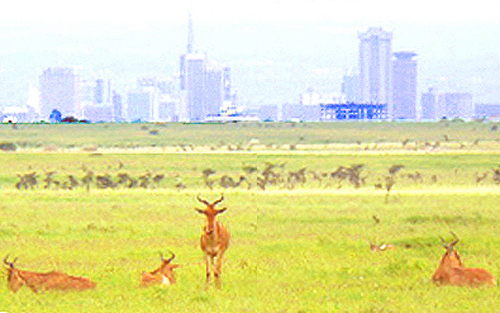
I’m not protesting; I’m not asking you to sign the petitions that successfully stopped the highway through the Serengeti, I’m just sick with nostalgia. This remarkable wilderness has survived with its ups and downs next to one of the most rapidly growing urban areas in Africa.
But with cloverleafs blooming all over Nairobi city, clovers have to go.
The very first wild animal I ever saw was in Nairobi National Park. My wife, Kathleen Morgan and I, flew into Nairobi directly over the park (still do) and I saw giraffe below the wing. We had hardly been in the city for a day in the early 1970s when I rented a car and drove to Nairobi National Park.
We paid our fees and drove onto the (then) dirt roads of Nairobi National Park and less than a minute later I had driven the Toyota onto a rock and we were totally stopped … about two feet from a rhino.
Rhinos were poached out of virtually all of wild East Africa in the next ten years (they’re coming back) and the city of Nairobi grew in leaps and bounds. The park did not grow. It remained as originally hardly 50 sq. miles, but also as always only three sides are fenced. The southeast side is open to the semi-wild country of the Athi Flats.
That used to be wild Maasai land all the way to Amboseli National Park. But soon a huge manufacturing area near Athi River town developed, along with some ground mining further south, and large ranches further west.
But small corridors remain open to the Amboseli/Tsavo/Kilimanjaro wilderness, although animals have to cross a major highway to get there. And even today you can find giraffe, zebra and wildebeest, and thanks to the special care of the Kenyan Wildlife Service, even a rhino and from time to time, lion.
It’s absolutely striking to see these wild animals beneath a skyline that is quickly rivaling the looks of an Asian city in explosive mode.
Couldn’t last.
Nairobi is in desperate need of highways to relieve the unbelievable congestion of traffic. And while the plan presented presumes that the land lost will be made up in a sort of triangular acquisition of adjacent farmland, this will absolutely break up the existing long-distance corridors.
And local Kenyan opponents are particularly concerned about the lost of trees. The park has been a nursery of sorts for tree farms often created in compensation for other parts of the city’s forested areas lost to housing and development.
The loss is stinging, but it isn’t in reality the catastrophe that the possible Serengeti highway would have caused, for example, and truly, it’s hardly a surprise. And if we’re to believe the wincing KWS officials, there may still be enough manageable land to sustain some grazers, and the park as always will remain a tremendous place to rehabilitate rescued wild life.
It’s all about clover or cloverleafs.